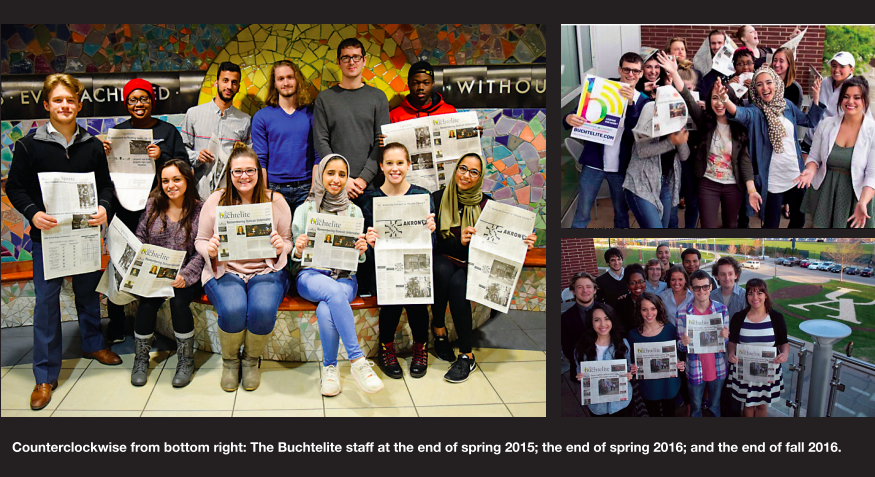“The University of Akron received 11 bomb threats over the weekend. The Auburn Science and Engineering Center, Kolbe Hall, the Polsky Building and Simmons Hall all received e-mail bomb threats in the last week. Police and the FBI are now working to find the responsible parties.”
“
The University of Akron received 11 bomb threats over the weekend.
The Auburn Science and Engineering Center, Kolbe Hall, the Polsky Building and Simmons Hall all received e-mail bomb threats in the last week. Police and the FBI are now working to find the responsible parties.
Jason D. Ford, of Akron, was arrested following the Kolbe Hall bomb threat Thursday. Ford, 27, is not a student and has been charged with inducing panic and making a false alarm, third and fourth degree felonies, respectively.
Unfortunately, the Kolbe Hall threat does not seem to be related to the other threats received, said University of Akron Police Chief Paul Callahan.
We are trying to trace the e-mail but that’s all under investigation, Callahan said. Basically, they (the e-mail) said there was a device in the building.
According to Ken Torisky, a senior public relations representative, the e-mail did say that no one should attempt to touch or move the device.
Callahan explained he did not want to release too much information on the e-mails in case this incident was something bigger and connected to other universities.
Threats not limited to UA
Several other colleges and universities nationwide received bomb threats last week. The University of Alaska-Anchorage, Carnegie Mellon, Cornell, Iowa, MIT, Middle Tennessee State, University of New Hampshire, Oregon State, Princeton, Western Illinois and William & Mary all received threats. Locally, Kenyon College and Lorain County Community College also received threats via e-mail.
The FBI and Department of Homeland Security are now working with the universities to track down anyone connected to these threats.
The e-mails were all very similar in nature in how they came in and what they said, FBI special agent Scott Willson said. We will work with all the different universities to try and find where the e-mail came from.
However, Willson said it could take time to track these threats.
It depends on if it was sent from the United States or not, he said. If it was overseas we have to work with foreign governments to track it down.
It depends on where it leads us to for how long it takes.
Similarly, a rash of bomb threats were phoned in to businesses nationwide during the same week. Willson said they do not believe them to be related to the university threats.
These other bomb threats were telephonic extortion bomb threats, he said.
New system helps UAPD plan response
Since the first threat, UAPD instituted the national incident management system, according to Callahan. UAPD decided to use the system after the Virginia Tech incident last spring.
The system allows you to organize and plan for a long-term event, he said.
Since the first e-mail, UA has been timely to inform students and the public on the situation.
In the first threat to the Auburn Science and Engineering Center, an e-mail was sent to an assistant dean in the College of Engineering. An administrative assistant received it at approximately 8 a.m. Shortly after, a special edition Zipmail was sent, notifying students before 8:30 a.m.
UA informs students through Internet
The university has updated students regularly regarding each threat via Zipmail, Zipline and the UA homepage. Each Zipmail also informed students that all other buildings on campus were remaining open.
Auburn was searched room-by-room using officers and bomb-sniffing dogs. It reopened at 1 p.m. and classes resumed by 4 p.m.
Kenyon College news director Mark Ellis said Kenyon conducted similar searches after receiving the e-mail threat.
As soon as we realized we were receiving the e-mail a meeting was called with the senior staff, he said. We discussed an evacuation, but we decided with the advice of the sheriffs’ office and fire department it was not necessary.
Ellis said they were told that if somebody were going to set off a bomb they wouldn’t give a warning.
We believe it was a similar threat other colleges received, he said. There was a sense it was likely a hoax.
Ellis said the e-mail did not mention Kenyon by name, or any building on campus.
Eleven threats received over holiday
The Polsky Building and Simmons Hall were partially closed Tuesday after 11 more duplicate e-mails were sent out, according to Torisky.
Torisky said that while the police dogs and officers searched the building, anyone who felt uncomfortable was encouraged to leave and come back later.
This is not the first time UA has received a bomb threat.
We had one in Simmons hall a couple years ago and we basically did the same thing, Callahan said. That was not an e-mail, it was a threat scribbled on a bathroom stall.
To date, every threat received by UA has been a hoax.
“
” #1.1361912:1084970826.jpg:map of bombs.jpg:Nationwide bomb threats were reported at several universities throughout last week. Threats have been reported at Alaska – Anchorage, Carnegie Mellon, Cornell, Iowa, MIT, Middle Tennessee State, University of New Hampshire, Oregon State, Princeton, Western Illinois and William & Mary. Locally, Lorain County Community College, and Kenyon College also received threats. Universities are now working in collaboration with the FBI and other law enforcement agencies to track down the origin of the e-mail. The e-mails received seem to be related and are very similar in text and method.:”
“#1.1361911:3793691024.jpg:KOLBE.jpg:Police Chief Paul Callahan talks to Cpl. Robert Stachowiak in front of Kolbe Hall after Thursday’s threat.:”
“#1.1361910:1549269585.jpg:028_070828_auburn_bombthreat2_kc.jpg:Sgt. Chad Cunningham, Captain Jim Weber and UA officials walk the perimeter of the Auburn building.:”

